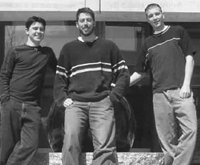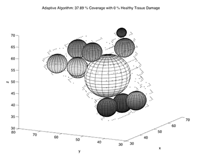The 2003 Mathematical Contest in Modeling
May 31, 2003

Aaron Windfield, Darin Gillis, and David Lindstone, members of the SIAM Student Chapter at the University of Colorado, Boulder, competed in MCM 2003 and earned the SIAM award for their solution to the B problem.
A SIAM Judge's Perspective
Four hundred ninety-four student teams participated in this year's Mathematical Contest in Modeling, now 19 years old. The students (mainly undergraduates, joined as usual by some high school students) had a choice of two problems, which were posted on the Web on Thursday evening, February 6; solutions were due by the evening of Monday, February 10.
Two hundred sixty-nine of the three-student teams elected to work on the (continuous) Problem A, while 225 chose the (discrete) Problem B. A total of 11 papers---six on Problem A and five on Problem B---were judged "outstanding," while 70 were deemed "meritorious" and 132 earned "honorable mention." It is expected that at least five of the outstanding papers will be published later this year in the UMAP Journal.
The setting for this year's A problem was a movie or video scene in which a stunt double rides a motorcycle up a ramp. The rider must be going fast enough to leap over an elephant, before landing in a carefully arranged heap of (apparently empty) cardboard boxes; the boxes are intended to enhance the visual effect by scattering spectacularly and at the same time to save the rider from serious injury by cushioning his fall.
Contestants were called on first to calculate the motorcycle's trajectory through the air, and then to arrange the boxes in a manner calculated to provide as safe a landing as possible under the circumstances. Given little guidance on the mechanical properties of cardboard, the contestants had to rely on assiduous Internet searches to come up with realistic and tractable formulations of the cyclist's landing impact.
The more socially consequential B problem concerned the use of a "gamma knife," a helmet-like device containing numerous weak gamma ray sources. By placing such helmets on the heads of brain cancer victims, and by aiming all the beams at (small) regions of diseased tissue, doctors can hope---without damage to the rest of the brain---to irradiate target regions to such an extent that the malignant cells located in them cease to grow. The entire treatment lasts for perhaps half a day, and irradiates at most 15 target volumes within the malignant region. Experience demonstrates that such treatment can extend the normal life of the patient for several years without invasive surgery.
The roughly spherical target volumes in which the gamma ray beams intersect must not be allowed to overlap: Cells located in the lens-shaped "hot spots" where spheres overlap tend to die instead of merely cease to grow, which is harmful to the patient. It is also medically important that the target spheres include little or no healthy tissue. Currently available equipment can irradiate spheres of four sizes: small (4 mm in diameter), medium (8 mm), large (14 mm), and extra large (18 mm). Given the size and shape of a malignancy, the technician in charge must try to include as much of it as possible within the 15 or so available spheres, without creating hot spots or exposing healthy tissue.
The technician's problem therefore reduces to one of packing a given volume of space with spheres of unequal sizes. It differs from traditional sphere-packing problems in that (i) at most 15 spheres can be employed, (ii) the spheres do differ in size, and (iii) certain volumes are impossible to pack tightly. Whereas three-dimensional space can be filled to a density of roughly 74% with spheres of equal size, a spherical malignancy slightly less than 8 millimeters in diameter will accommodate no more than a single one of the given spheres and can thus be packed to a maximum density of about 12.5%. Only the bravest contestants were prepared to concede that their algorithms might fail to achieve even 50% coverage.
The outstanding papers on the A problem came from the University of Washington, Zhejiang University in China, Harvard, Southeast University, Caltech, and Harvey Mudd College, with the MAA award going to team 24, from the University of Washington; the INFORMS award to team 177, from Zhejiang; and the SIAM award to team 526, from Caltech. The outstanding papers on the B problem came from the University of Washington, Peking University, Dong Hua University, the University of Colorado at Boulder, and Youngstown State University, with the MAA award going to team 611, from Youngstown State; the INFORMS award to team 25, from the University of Washington; and the SIAM award to team 457, from the University of Colorado. Both SIAM winners have been invited to present their prize-winning papers at a special session of the 2003 SIAM Annual Meeting in Montreal.---James Case, Baltimore, Maryland.
A Winning Team's Perspective
Necessary Materials for Success in the MCM:
- 1 analytic mathematician type
- 1 math-English hybrid type
- Unlimited checkout permission from library
- 8 computers running MATLAB simulations
- Empty conference room with alarm clock
- 1 sleeping bag per team member
- Variety of take-out menus
The intense four-day ordeal known as the MCM begins with fresh optimism and lofty goals. The contest ends with frantic writing inspired by little rest and nervous energy. Everything in between is, well, something that one has to experience firsthand.
The key to victory is a solid, balanced team. One person takes the reins on research, always looking for that one paper that will give the team an "edge" that will impress the judges. Another person must slave over the computer, creating and running the simulations that will become the central topic of the paper. The third member has the difficult task of producing a clear and concise paper that will be accessible to all. By working in parallel, the team can optimize the use of its time; but in the end, each person must contribute to find that one creative thing to add to the paper that makes it unique.
Our team selected the problem about gamma knife radiosurgery for cancer treatment. We thought it would be rewarding to choose a problem that seemed sophisticated and thought-provoking. More importantly, when we saw the problem, we knew that we could tell everyone "our project consisted of techniques in surgery and treatments for cancer."
On Day 1, we began to research the problem, reading countless medical journals and mathematics/computer science publications---until we had found the paper that yielded "grass-fire": the algorithm that became the basis for our first model. Day 2 consisted of coding up the first model and dreaming up new ideas for more complicated models. (Note that there is no quality sleep to be had between Day 1, Day 2, Day 3, and Day 4---except for what can be gained in a sleeping bag in the nearest conference room.) Day 3 and Day 4 consist of refining the models, finishing up the code, and crystallizing our thoughts in the paper.

From the winning solution: the Boulder team's spheres filling a tumor.
The last day is the crucial period-we ran the final simulations (on at least eight computers) and revised and reorganized the paper (at least 10 times). We spent the last hour writing the abstract as a group, on a blackboard. By the time the whole paper came together (five minutes prior to the 6 P.M. deadline), the great feeling of satisfaction motivated us down the hallway to the copy room, where we handed in the paper. We were lucky enough to have the right ingredients to attract the SIAM prize, and are very grateful that our hard work was rewarded. And yes, it was definitely worth it.---Aaron Windfield, Darin Gillis, and David Lindstone, University of Colorado, Boulder.
An Adviser's Perspective
The modeling contest actually begins in the late fall. At this time we recruit the students and have two or three training sessions before the winter break. At these sessions, we introduce the students to the nature of the contest and give suggestions on how to manage the four-day time constraints. But, most importantly, these sessions give the students time to get to know one another and to begin to form their teams. Ideally, the teams have coalesced before the end of the year.
From the adviser's perspective, the most important ingredients for a winning team are three talented students who are well trained and have a well-developed team dynamic. In fact, a cohesive team structure is critical for bringing out the most creative solutions. Throughout the contest, I saw David, Aaron, and Darin working individually and in intense conversation. Their collaboration resulted in a solution paper that was greater than the sum of its parts-three outstanding students truly working together!---Anne Dougherty, Department of Applied Mathematics, University of Colorado, Boulder.

